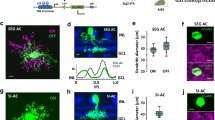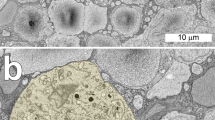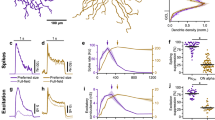Abstract
Slaughter and Miller have recently demonstrated that in the isolated eye cup of the mudpuppy and the rabbit, DL-2-amino-4-phosphonobutyric acid (APB) reversibly blocks the ON responses in the retina: on infusion of APB, ON bipolar, ON amacrine and ON ganglion cells become unresponsive; receptors, horizontal cells, OFF bipolars, OFF amacrines and OFF ganglion cells are unaffected1. The centre-surround organization of OFF-centre ganglion cells appears unaltered. I have used these findings to determine how the ON-centre and OFF-centre retinal ganglion cells, whose characteristics have been extensively studied in mammals2–7, exert their influence on the neurones of the central visual system. Recordings made in the lateral geniculate nucleus (LGN) and striate cortex of the rhesus monkey while the retinal ON responses were reversibly blocked with APB showed that in the LGN, retinal APB infusion blocked the responses of ON-centre cells and had little effect on OFF-centre cells. The centre-surround organization of OFF-centre cells was unaffected. APB infusion eliminated the light-edge responses of cortical cells, revealed a dark-edge response in some, but had no discernible effect on orientation and direction specificities. These results suggest that the ON and OFF systems do not interact significantly at the level of the LGN, but do so in the striate cortex.
This is a preview of subscription content, access via your institution
Access options
Subscribe to this journal
Receive 51 print issues and online access
$199.00 per year
only $3.90 per issue
Buy this article
- Purchase on Springer Link
- Instant access to full article PDF
Prices may be subject to local taxes which are calculated during checkout
Similar content being viewed by others
References
Slaughter, M. M. & Miller, R. F. Science 211, 183 (1981).
Cleland, B. G. & Levick, W. R. J. Physiol., Lond. 240, 421 (1974).
DeMonasterio, F. M. & Gouras, P. J. Physiol., Lond. 251, 167 (1975).
Enroth-Cugell, C. & Robson, J. G. J. Physiol., Lond. 187, 517 (1966).
Kuffler, S. W. J. Neurophysiol. 16, 37 (1953).
Schiller, P. H. & Malpeli, J. G. J. Neurophysiol. 40, 428 (1977).
Stone, J. & Fukuda, Y. J. Neurophysiol. 37, 722 (1974).
Cunningham, R. & Miller, R. F. Brain Res. 117, 341 (1976).
Schiller, P. H., Finlay, B. L. & Volman, S. F. J. Neurophysiol. 39, 1288 (1976).
Schiller, P. H. & Malpeli, J. G. Brain Res. 137, 387 (1977).
Dreher, B., Fukuda, Y. & Rodieck, R. W. J. Physiol., Lond. 258, 433 (1976).
Schiller, P. H. & Malpeli, J. G. J. Neurophysiol. 41, 788 (1978).
Wiesel, T. N. & Hubel, D. H. J. Neurophysiol. 29, 1115 (1966).
Hubel, D. H. & Wiesel, T. N. J. Physiol., Lond. 155, 383 (1961).
Maffei, L. & Fiorentini, A. J. Neurophysiol. 35, 65 (1972).
Hubel, D. H. & Wiesel, T. N. J. Physiol, Lond. 195, 215 (1968).
Hubel, D. H. J. opt. Soc. Am. 53, 58 (1963).
Horton, J. C. Neurosc. Abstr. 7, 11.8 (1981).
Author information
Authors and Affiliations
Rights and permissions
About this article
Cite this article
Schiller, P. Central connections of the retinal ON and OFF pathways. Nature 297, 580–583 (1982). https://doi.org/10.1038/297580a0
Received:
Accepted:
Issue Date:
DOI: https://doi.org/10.1038/297580a0
This article is cited by
-
Ring analysis of multifocal oscillatory potentials (mfOPs) in cCSNB suggests near-normal ON–OFF pathways at the fovea only
Documenta Ophthalmologica (2020)
-
Computerised campimetry with static dark-on-bright stimuli
Documenta Ophthalmologica (1993)
-
A unified neural model of spatiotemporal processing in X and Y retinal ganglion cells
Biological Cybernetics (1992)
Comments
By submitting a comment you agree to abide by our Terms and Community Guidelines. If you find something abusive or that does not comply with our terms or guidelines please flag it as inappropriate.



